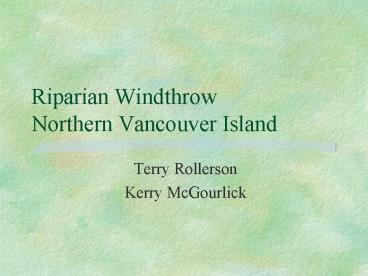Riparian Windthrow Northern Vancouver Island
1 / 33
Title:
Riparian Windthrow Northern Vancouver Island
Description:
Document the extent/character of riparian windthrow on Northern Vancouver Island ... Visual estimates of windthrow percentage, penetration, spatial pattern, ... –
Number of Views:81
Avg rating:3.0/5.0
Title: Riparian Windthrow Northern Vancouver Island
1
Riparian Windthrow Northern Vancouver Island
- Terry Rollerson
- Kerry McGourlick
2
Study objectives
- Document the extent/character of riparian
windthrow on Northern Vancouver Island - Evaluate the factors associated with riparian
windthrow - Document the effects on stream channels
- Develop windthrow control strategies
- Develop a monitoring/database system
3
Methodology
- Ground surveys of 76 km of pre and post FPC
riparian edges, S1 to S6 streams - 447 variable length plots defined by homogeneous
stand, soil, terrain, stream reach boundary
characteristics - Visual estimates of windthrow percentage,
penetration, spatial pattern, orientation and
effects on streams
4
Visible stream effects
- 95 of the stream reaches surveyed had no
visible streambank disturbance. - 4 had 5 streambank disturbance
- 1 of the stream reaches had 10-20 streambank
disturbance - 64 of the stream reaches were spanned by
windthrown trees and 36 were not.
5
Stream class vs windthrow
6
Windthrow distribution
7
Windthrow penetration pattern
8
Windthrow severity index (WSI
WTPenetration Distance)
9
Single vs double-sided strips
10
Treatment plus leave strip effects
11
Windthrow vs width (1-sided strips)
12
Windthrow vs width (2-sided strips)
13
Windthrow vs boundary exposure
14
Wind Exposure Index WEI (BE 1 rank) (BE 2
rank)
15
Windthrow vs exposure index
16
Windthrow vs valley axis
17
Windthrow vs boundary geometry
18
Windthrow vs rooting depth
19
Windthrow vs soil drainage class
20
Windthrow vs dominant tree species
21
Windthrow vs height class (map)
22
Windthrow vs stand age
23
Untreated and feathered riparian strips
24
Best Predictors
- Dominant species
- Wind exposure
- Rooting depth
- Boundary-slope geometry
- Stand characteristics (age/height/density)
- Leave type (1 vs 2-sided)
- Strip width
- Edge treatment
25
Summary
- Average riparian windthrow 21
- Average penetration distance 13 m
- Windthrow and penetration is greatest on windward
boundaries 16 m - Deeper rooting and taller trees are associated
with more windthrow
26
Summary continued ...
- 2-sided riparian strips have more windthrow than
1-sided (external) strips (15 vs 27) - Feathering reduces windthrow (11 vs 19)
- Wide strips are more windfirm than narrow strips
- Young stands are more vulnerable
- e.g., 1908 windthrow
- second growth
27
Summary continued ...
- Cedar dominated stands are more windfirm
- Boundaries setback from the edges of gullies have
less windthrow - Windthrown trees span streams, but rarely cause
significant bank disturbance
28
Some options for high risk areas
- Log to streambank on one side
- stable gullies
- small streams
- Substitute more retention on low hazard S4s for
less retention on high hazard S3s - Fall, leave logs spanning stream for LWD
- Remove doms and co-doms (fall some across), but
retain and top intermediates
29
Options for high risk areas contd
- Fall tall trees growing on streambanks
- Log to base of escarpments with floodplains
- Log lee edges in young stands. Allow the stand
time to adapt to increased wind forces before
logging windward edges, or .. - log a narrow strip along windward edges so that
there is some wind protection from upwind stand
edges for a period of time
30
Some Preliminary Observations on Retention
Silviculture
31
Observations on retention
- Pre-harvest windthrow assessment is critical
- Manage with local data for local conditions
- treat conventional wisdom with caution
- Manage for risk not hazard
- Carry out post-mortems blocks and basins
- Monitor and document windthrow patterns
- Adapt
32
Observations on retention
- The factors controlling windthrow with retention
silviculture will be similar to those found with
conventional clearcutting - Manage the edges of large patches as you would
external block boundaries - Manage dispersed retention using block strata and
individual tree characteristics - Make use of previously exposed areas/edges
33
Observations on retention
- Large patches may survive better than small
- Narrow strips and ribbons are vulnerable
- Multi-storied stands/edges that can be easily
feathered will be more windfirm - Young uniform stands - may be vulnerable
- Minimize windward edges
- Setback from windward edges along the tops of
escarpments and unstable gullies































